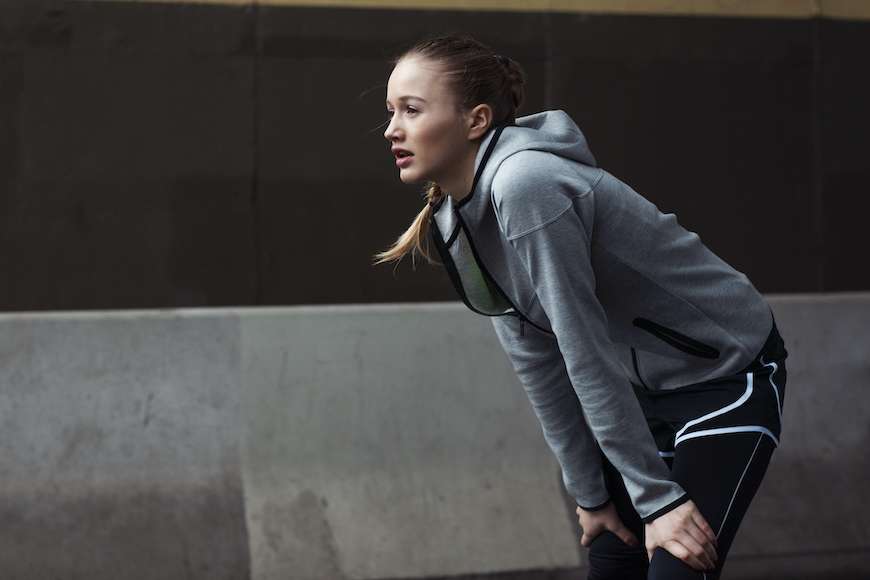W
orking out has long been talked about as an antidote to stress and anxiety, a way to work through racing thoughts or get a much-needed endorphin boost. Science is clear that working out isn’t only good for your body,
orking out has long been talked about as an antidote to stress and anxiety, a way to work through racing thoughts or get a much-needed endorphin boost. Science is clear that working out isn’t only good for your body, it’s good for your mind, too —imperative even. But for some people, breaking a sweat doesn’t make them feel relaxed or less anxious. In fact, it can have the opposite effect, bringing on feelings of anxiety that are hard to put to rest, even once the foam rolling is finished. It’s enough to make someone want to toss their sneakers into the deep, dark corner of their closet and stop working out for good.
However, given how truly beneficial exercise can be, mental health experts say that ditching your shoes forevermore isn’t always the answer. Here, therapists who specialize in the connection between exercise and mental health explain why, for some, working out can be anxiety-inducing and the best ways to overcome it. Because, according to them, it’s absolutely possible to turn working out from something that causes anxiety to something that calms it.
Pinpointing the root issue that’s causing your anxiety while exercising
Sepideh Saremi, LCSW, the founder of Run Walk Talk, which combines a therapy session with running or walking, says people with a history of panic attacks can often feel anxious when exercising. That’s because the physical changes that happen to your body while you’re working out—shortness of breath, a fast-beating heart, sweating—mimic symptoms of anxiety. “It can start to feel [physically] similar to their panic attacks and take them back to their mindset at that time,” she says.
The same way that our minds retain information about past experiences and what we’ve been through, so too, do our bodies log memories of past experience. There are neural explanations as to why: The same way that we have five senses for perceiving the outside world, our internal body has “senses” that help to alert the brain to respond to specific stimuli. The vestibular system, which is located in the inner ear and brain and helps to modulate movement, works in close proximity with the limbic system, which controls our body’s autonomic nervous system (the body’s fight or flight command center) as well as emotional response, memory, and learning.
Related Stories
When you put the body into “flight” mode to run a few miles or catch a Peloton spin class with friends, this can cause the body to go fast and the mind to pick up the pace with anxious or racing thoughts as well. In many ways, our bodies are biologically programmed to respond to stimuli, and whether there’s a lion chasing us or a Nike Run Club Challenge to conquer, our brains aren’t always fully capable of separating the motion of run from the reality of threat. That’s why some studies have found that, in patients with a history of panic disorder, exercising caused a spike in anxious thoughts.
Fears of physical limitations, too, can cause anxiety to spike. If someone has heard of a loved one, or someone in the news, experiencing a heart attack or another health problem while exercising, it can cause a fear of that happening to them as well. As soon as their own heart rate starts to increase, they can become preoccupied with the worry that it’s a sign of a heart attack. Elion also says if someone has experienced a health issue while exercising in the past, they can become consumed with worry that it will happen again.
Sports psychologist Julie Elion, founder of the Center for Athletic Performance Enhancement, says exercise-induced anxiety isn’t uncommon in those with pre-existing conditions. “It’s something I hear quite often from people who are over 50—or even 40—and have concerns about heart health,” she says. This is why her very first piece of advice is to get a check-up from a doctor, getting the all-clear before working out. “This will provide peace of mind that you don’t have any health issues and you’re physically able to withstand exercise,” Elion says.
What to do if anxious thoughts occur during workouts
No advice can ever take the place of a mental health expert who knows your exact experience, so if you’re feeling anxious, make sure to consult with a licensed professional first and foremost to get to the root of your stress and anxiety. There’s no simple fix to relax the mind; however, in a given workout there are things you can do to ease anxiety so that you can reap the benefits in the long run.
Elion suggests listening to music or a podcast as a way to relax your mind. Saremi co-signs this, but only coupled with doing the deeper work of finding the core reasons for your anxiety, which she emphasizes is most important. “Distraction is a really great short-term strategy, but if it’s a recurring problem, it’s not necessarily going to help you actually face the problem and learn to cope with it,” she says.
Saremi says part of the solution to overcoming anxiety during exercise is getting to the root cause of why you’re feeling anxious. (Yep, that means you might even want to book yourself some therapist time—even virtually.) “There are ways to cope in the moment, but if you don’t get to the root of why you feel stressed or anxious, it will become a recurring issue,” she says.
Both experts say working out with a friend can also be helpful. “I think this is a great thing to do because running [or working out] with someone that you feel comfortable with and that if you do start to panic they feel okay being there for you can be really powerful,” Saremi says. Working out with someone provides the assurance that if something does go wrong, or you start to feel anxious, you won’t be alone.
You also might be able to curb your feelings of anxiety by switching up your workout. “If the feeling of your heart starting to beat faster makes you feel anxious, try lower-impact workouts instead,” Elion says. “Movement is really key for managing anxiety but it doesn’t have to be high-impact. Exercises like yoga or Pilates can be incredibly beneficial for both physical and mental health.”
Saremi says that many of her clients are overachievers who struggle with anxiety and often they put pressure on themselves to go above and beyond with their workouts, too. “Something I often have to train them out of is the thinking that a workout ‘doesn’t count’ if they walk instead of run or they don’t go a certain pace,” she says. “Running [and your workouts] belong to you. You get to decide what works for you.”
Once you start to start to feel okay working out at a less intense level, Elion says you can increase it slowly. Saremi recommends this, too, and says you don’t have to “push through” feeling anxious in an effort to prove to yourself that you’re okay. In fact, she recommends not doing this. “If you start feeling anxious, slow down to bring your heart rate down,” she says.
Saremi also recommends a grounding exercise to try in the moment while working out: Notice five things you can see, four things you can feel, three things you can smell, two things you can hear, and one thing you can taste. When incorporating your senses into your exercise, you can re-train the body to respond to fitness in a more calming and stress-relieving way. “This brings yourself back to the present moment,” she says. In doing so, you’ll realize that you are okay, you are safe.
This isn’t to say that everyone should avoid exercising because it may or may not trigger their anxiety. On the contrary, if you find that exercise reduces all your stress and anxiety symptoms, keep on keeping on. But if you feel like your anxiety increases as the result of a workout, you deserve expert advice on how to handle it and find ways around it.
Of course, everyone is different (surprise!), which makes this topic a bit tricky. A workout that stokes one person’s anxiety could be totally fine for another, and some people with anxiety can do any type of workout and feel fine. It’s probably going to take some trial and error on your end, but there are some workouts that are more likely to increase our anxiety—ones that anxious folks may want to avoid.
To get some answers, we asked holistic psychiatrist Ellen Vora, M.D., and trained gynecologist and obstetrician Anna Cabeca, D.O., to weigh in.

Share on Pinterest
Guille Faingold/Stocksy United
The symptoms experienced during both a workout session and a panic attack are surprisingly similar. Their relationship is closer than you may have thought.
Aside from improving your cardiovascular, muscle, and bone health (to name a few), working out regularly also offers a surplus of mental health benefits, including reduced anxiety and stress levels.
“Research has shown that exercise can be a remedy for anxiety and calms the sensory nervous system, produces endorphins [the ‘feel-good’ hormone], and lowers your resting heart rate,” says Dr. Andreas Michaelides, chief of psychology at Noom in New York City.
However, a zealous exercise session can have the opposite outcome for some, inducing feelings of anxiety and even triggering full-blown panic attacks.
So what’s behind this, and how can you help keep the endorphins and ditch the escalation?
Can exercise trigger panic attacks?
Sort of. While the physical act of exercise itself doesn’t directly induce panic attacks or anxiety, the ripple effects that follow can.
If you’ve experienced a panic attack, you’re well aware of some of the symptoms — sweating, increased heart rate, shortness of breath, dizziness, and nausea. Many of these can also arise after cardio or high intensity interval training (HIIT) workouts.
Sensing signs of a panic attack while exercising can cause anxiety and stress for some. But what’s the science behind it?
“Exercise, particularly strenuous exercise, can stimulate our bodies’ own defense system or fight-or-flight response,” says Dr. Jeffrey Ditzell, a psychiatrist in New York City.
“Panic attacks are… defined as a physiologic over-response to what might be considered normal physiologic stress. Exercise-induced panic can be experienced as one increases the intensity of effort, stimulating our sympathetic nervous system to prepare to flee or to fight,” Ditzell says.
Once physical symptoms of panic start, inner turmoil can awaken and exacerbate the experience.
“There may be fears that something specific and feared will happen. For example, that they will collapse, faint, die, wet themselves, be humiliated,” explains Dr. Marianne Trent, an author and clinical psychologist in Coventry, U.K. “This continues to trigger the physical symptoms.”
As a result, it can quickly become a vicious cycle.
Does the type of workout play a role?
While some workouts encourage a higher calorie burn and others build strength, it’s less clear-cut regarding panic and anxiety.
“You are more likely to experience anxiety with intense workouts because cardiovascular activity increases heart rate and blood pressure,” says Dr. Meghan Marcum, chief psychologist at A Mission For Michael in San Juan Capistrano, California. “[And] anxiety symptoms also include increased heart rate and blood pressure.”
But Trent adds it’s important to note that everyone’s situations are different. “Anything which raises the heart rate, changes the breathing rate, and makes someone sweaty could contribute to panic,” she says.
“Sometimes, certain types of trauma panic can be triggered when someone gets their body into a certain position,” Trent says. So while Child’s Pose might be super relaxing for some, for others, it could be more panic-inducing than the prospect of sprint circuits.
Additional triggers to watch out for
“External stressors, your level of physical conditioning and current resources, and prior recovery can all play a role in how you may experience your exercise routine,” Ditzell says.
Ever drink a coffee or energy shot before a workout to gain an extra boost? You’re not alone: Plenty of us do so — caffeine has been shown to stimulate numerous areas of the body and enhance performance, focus, and even levels of fat burning.
However, when it comes to panic attacks, “caffeine and anxiety do not make good bedfellows,” states Trent. “Because many of the physical impacts of caffeine can feel a lot like anxiety anyway, taking this stimulant can lead to people noticing these physical symptoms more, which can keep the panic cycle going.”
Whether you’re at the gym or running through the park, social pressures can encourage feelings of panic, too.
“Some may experience symptoms when facing situations of changing in front of others, being intimidated by others who are in better shape, fear [about] using the equipment correctly, and even making small talk before a group exercise class,” Michaelides says.
Plus, studies confirm that exercising in a competitive environment triggers psychological and physiological stress responses, especially in those prone to anxiety.
What can I do to ease anxiety during exercise?
Bodily activity is crucial for mental and physical health, so avoiding it isn’t a good idea. Plus, notes Michaelides, “avoidance reinforces this anxiety.” You can take steps to lower your risk of feeling anxious and ease yourself out of a panic attack.
Look after your noggin
“Anxiety thrives in a busy world like ours, so it’s important to practice mental health hygiene to keep anxiety levels low across situations, including during the times we exercise,” states Marcum.
Mental health hygiene can include:
- engaging with friends
- reducing screen time
- consistent sleep
- self-compassion
Breathe easy
To get your breathing back on track and your heart rate pounding at a more reasonable rate, “soothing rhythm breathing is great,” suggests Trent.
It’s as easy as it sounds: Through your nose, slowly breathe in for a count of four, then back out for a count of four, and repeat. Want to know more? This article explains how and why deep breathing is a great anxiety reducer.
Know when to take a break
If you feel anxiety or panic creeping up during your workout, recognize that it’s better to stop rather than push on. “Drink some water, and don’t be afraid to sit down for a while,” Marcum says. Doing so will help you get on top of things before they spiral.
Speak with a therapist
The heightened anxiety you feel when experiencing panic attack-type symptoms may be rooted in a deeper issue, so it’s worth speaking with an expert to learn strategies to identify and treat whatever may be fueling your feelings.
“I would encourage anyone experiencing panic to reach out to an appropriately qualified mental health professional, such as a clinical psychologist, so that the appropriate changes can be made to help overcome the difficulties experienced,” Trent recommends.
Let’s recap
Although there’s a definite relationship between the two, exercise itself doesn’t induce anxiety nor panic.
Rather, the physiological responses that arise can act as a trigger. And, while those who regularly experience panic are at greater risk of an exercise-related panic attack, anyone can have one.
Plus, a HIIT workout may be more likely to encourage the physiological reactions we often link with panic attacks — increased heart rate and faster breathing. But everyone’s reactions to exercise are varied, so something easier could still produce panic.
Using tactics that can help ease anxiety and break the cycle of panic, you can get back to working on being your strongest and healthiest self. After all, exercising for health is important, but it’s also meant to be enjoyed!




